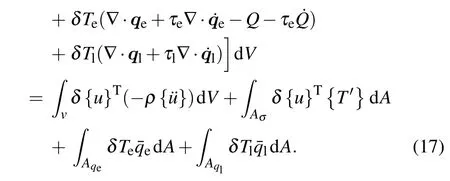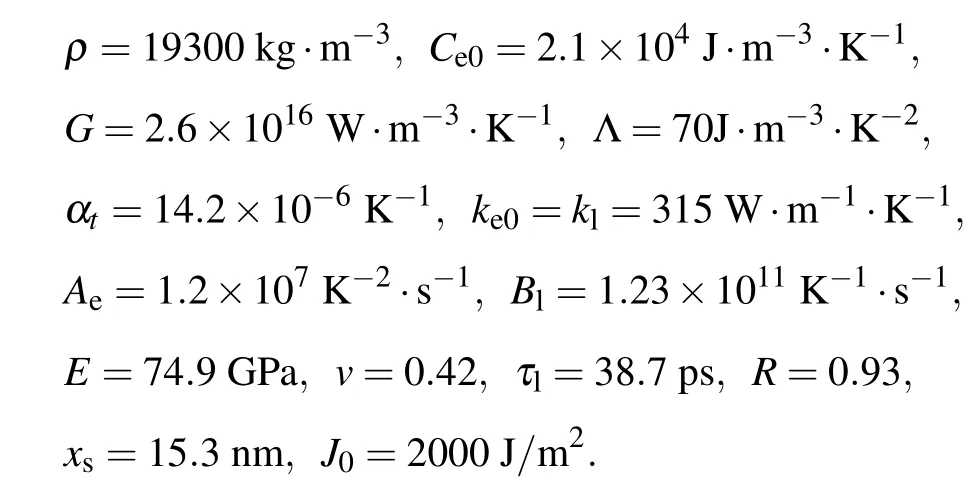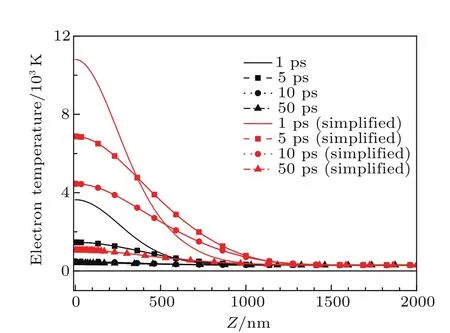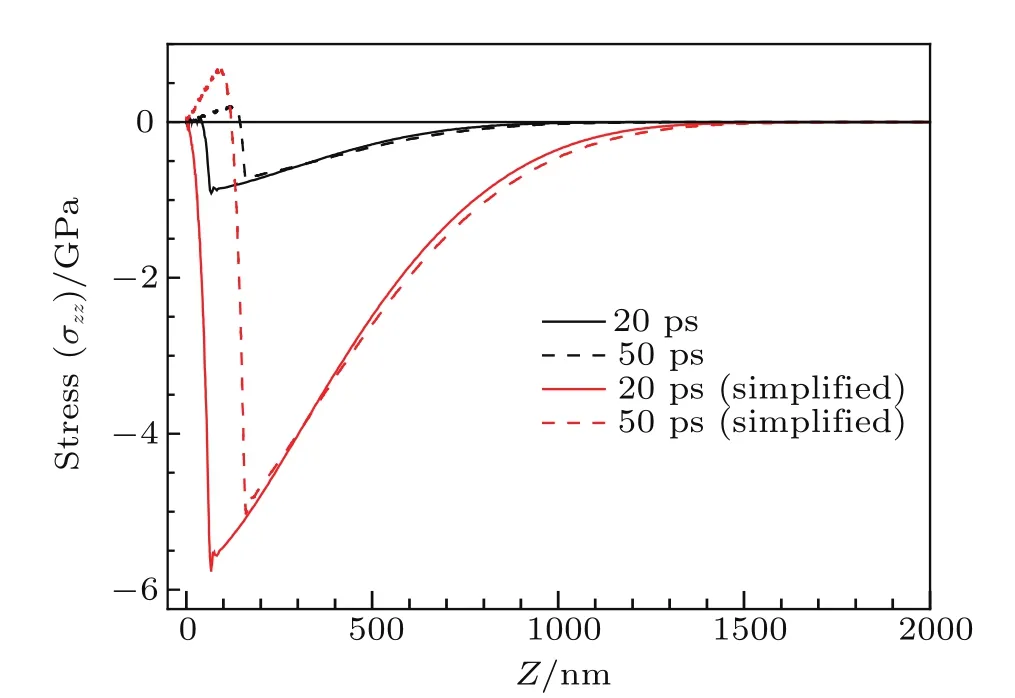Effect of ballistic electrons on ultrafast thermomechanical responses of a thin metal film∗
2017-08-30QilinXiong熊启林andXinTian田昕
Qi-lin Xiong(熊启林)and Xin Tian(田昕)
1 Department of Mechanics,Huazhong University of Scienceamp;Technology,Wuhan 430074,China
2 Hubei Key Laboratory of Engineering Structural Analysis and Safety Assessment,Wuhan 430074,China
3 School of Mechanical Engineering,Xi’an Jiaotong University,Xi’an 710049,China
Effect of ballistic electrons on ultrafast thermomechanical responses of a thin metal film∗
Qi-lin Xiong(熊启林)1,2,†and Xin Tian(田昕)3
1 Department of Mechanics,Huazhong University of Scienceamp;Technology,Wuhan 430074,China
2 Hubei Key Laboratory of Engineering Structural Analysis and Safety Assessment,Wuhan 430074,China
3 School of Mechanical Engineering,Xi’an Jiaotong University,Xi’an 710049,China
The ultrafast thermomechanical coupling problem in a thin gold film irradiated by ultrashort laser pulses with different electron ballistic depths is investigated via the ultrafast thermoelasticity model.The solution of the problem is obtained by solving finite element governing equations.The comparison between the results of ultrafast thermomechanical coupling responses with different electron ballistic depths is made to show the ballistic electron effect.It is found that the ballistic electrons have a significant influence on the ultrafast thermomechanical coupling behaviors of the gold thin film and the best laser micromachining results can be achieved by choosing the specific laser technology(large or small ballistic range). In addition,the influence of simplification of the ultrashort laser pulse source on the results is studied,and it is found that the simplification has a great influence on the thermomechanical responses,which implies that care should be taken when the simplified form of the laser source term is applied as the Gaussian heat source.
ultrafast thermomechanical coupling,ballistic electrons,ultrashort laser pulse,finite element method
1.Introduction
The investigation of interactions between femtosecond lasers and thin metal films is drawing increasing attention.[1,2]For femtosecond pulses,it has been assumed that the laser energy is primarily absorbed by the free electrons that are confined close to the surface.Hence,a strong nonequilibrium between the energy carriers,namely,the electrons and phonons, is created in this process.In this highly nonequilibrium state, ballistic motion of electrons into deeper parts of the sample with velocities close to the Fermi velocity will take place.The ballistic energy transport occurring before the thermalization of the electron gas has been found to play an important role in the initial energy redistribution in targets irradiated by femtosecond laser pulses.[3–6]
Due to the complexity of the process of ballistic electrons transport,most investigations cannot offer the non-equilibrium electron distributions in the sample exactly.It is a good choice to add the ballistic range to the laser penetration depth in the laser source term to incorporate this effect of ballistic electrons,[4,7–10]as given below:

where xsis the transmission depth of the laser,J0is the laser fluence,R is the reflection coefficient of the laser pulse,tpis the laser pulse duration and constant,and β is equal to 4ln(2). Here λballis the ballistic range.However,the ballistic range has taken different values from tens of nanometers to hundreds of nanometers for the same material in different works.In some works,equation(1)is simplified as follows:

In fact,the ballistic range can take different values for different laser types,such as CO2lasers(gas lasers),fiber lasers, Nd:YAG(crystallasers).According to the work of Thomsen et al.,[11]the laser penetration depth(xs+λball)can be estimated by

where λ is the wavelength of the laser and κ is the imaginary part of the refraction index of the thin film.Due to the significant difference of laser wavelength between different laser types,[12]the laser penetration depth can be varied from a few nanometers to several hundred nanometers.
The main aim of this work is to investigate the effect of ballistic electrons on ultrafast thermomechanical coupling behaviors and the influence of simplification of the laser source term.The numerical results can provide a theoretical guid-ance for choice and application of the laser type against different engineering requests.The ultrafast thermoelasticity (UTE)model developed by Chen et al.[13]extending the dual-hyperbolic two-temperature and hot-electron blast model[14]is applied to study the ultrafast thermomechan-ical behaviors of a gold film subjected to femtosecond laser heating in the present work.The finite element method is applied to solve the problem in the present work due to the successful usage of finite element method in the investigations of thermomechan-ical responses of metallic films under ultrashort pulse laser heating.[15,16]
2.Mathematical model
An immense homogeneous,isotropic,gold thin film(0≤x≤L,L is the film thickness,L=2µm)whose surface is heated by laser beams of radius r0is considered in this work (r0>>L).In view of the fact that ultrafast deformation takes place in a very short period of time,it is assumed that both the thermal transport and the lattice deformation do not occur immediately in directions normal to the thickness direction. Therefore,within the heated spot the thermal transport can be treated as a 1D process and the mechanical response is in a state of uni-axial strain but 3D stress.[15,16]
The field equations of the ultrafast thermoelasticity (UTE)model developed by Chen et al.[13]extending the dual-hyperbolic two-step heat transfer and hot-electron blast models[14]are given as follows:

For a solid medium irradiated by a Gaussian laser beam, the volumetric laser heat source Q(x,t)without ballistic range in Eq.(10)is expressed in the 1D form

The laser power outside the period of the lasing time assumed here is ignored because of the small amount of energy.
企业均是将经济效益最大化作为最终目标,即使国有企业根据时代发展所提出的全新要求不断对自身进行改革,但在市场经济环境中,仍然存在仅仅重视经济效益与市场地位,对企业内部思想文化建设轻视的现象。同时部分国有企业管理者未在企业内部起到良好的带头作用,在实际工作过程中严格要求员工,而对自身的要求却相对放宽,导致思想政治工作不具备足够的说服力,使员工出现逆反心理。随着新时期市场经济体制改革和政治改革的不断深入,企业发展和员工精神方面需求之间的矛盾愈发凸显,需要国有企业不断加强其内部思想政治工作,以便化解矛盾,实现国有企业和谐稳定发展。
When the effect of the ballistic electrons is considered, the Gaussian laser source term can be changed to[4,7–10]

The simplified form of the Gaussian laser source term with the effect of the ballistic electrons is as follows:[17]

From the preceding description and the problem we will consider,the initial and boundary conditions may be expressed as follows:

3.Solutions of the finite element equations of problem
According to the heat conduction equations,equations of motion,constitutive equations,and boundary conditions,using the generalized variational principle,we obtain at any time


At the right side of the above equation,andare the external force vector,the external electron heat flux,and the external lattice flux vector,respectively.Then the finite element governing equations can be established and solved in the time domain directly by associating with the corresponding initial conditions and boundary conditions.
4.Results and discussion
Due to the ultrashort interaction time,the thermal loss at the surface of the gold film is ignored in all the calculations. The temperature-dependent thermal conductivity and heat capacity of the gold electron are given in the previous section. All thermophysical properties of gold used in the modeling are as follows:

First of all,we make the validation of the finite element method applied in the present study and the problem in Ref.[10]is reinvestigated.Figures 1 and 2 compare the numerically predicted electron and lattice temperatures with those of Ref.[10].It is found that the electron and lattice temperatures predicted by the finite element method agree very well with those in the reference.

Fig.1.(color online)Electron temperature profiles for a 100-nm gold film heated by a 100-fs laser pulse of J0=10 J/m2.

Fig.2.(color online)Lattice temperature profiles for a 100-nm gold film heated by a 100-fs laser pulse of J0=10 J/m2.
4.1.The effect of ballistic electron on the thermomechani-cal response
Figure 3 shows the electron temperature at the top surface under different ballistic ranges:(a)without ballistic effect;(b) λball=105 nm;(c)λball=500 nm.The highest electron temperatures of the three cases are 8.51×103K,4.94×103K,and 2.67×103K,respectively.The highest electron temperature decreases with the increase of the ballistic range,this is due to the fact that the optical penetration depth of the laser pulse is large and the laser energy is dispersed spatially;the total optical penetration depths of the three laser pulses are 15.3 nm, 120.3 nm,and 515.3 nm,respectively.

Fig.3.(color online)Electron temperature at the top surface versus time under different ballistic ranges.The top surface is the surface irradiated by the laser pulse.
Figure 4 shows the spatial distributions of electron temperature with different ballistic ranges at several time points. With the increase of the ballistic range,the electron temperature near the top surface decreases whereas the electron temperature of deep region in the film increases.When the ballistic range increases,the laser energy can be transferred to the deeper region of the film.Since the total laser energy is constant,the electron temperature in the thin film is affected by the ballistic range;the larger the ballistic range,the lower the electron temperature near the top surface,and the higher the electron temperature in the deep region of the thin film,as shown in Fig.4.These results show the effect of the ballistic electron has a great influence on the electron temperature.

Fig.4.(color online)The spatial distributions of electron temperature with different ballistic ranges at several time points:(a)1.0 ps,(b)5 ps, (c)50 ps.
The spatial distributions of the phonon temperature with different ballistic ranges at several time points are shown in Fig.5.Similarly,with the increase of the ballistic range,the phonon temperature near the top surface decreases,whereas the phonon temperature of deep region in the film increases. Additionally,the highest phonon temperature in the thin film decreases when the ballistic range increases.These results further show that the electron ballistic effect can influence the utilization of the laser pulse technology.Based on these results,we can choose the specific laser technology(long or short wave)to meet the special engineering requirements.

Fig.5.(color online)The spatial distributions of phonon temperature with different ballistic ranges at several time points:(a)5.0 ps,(b)10 ps,(c) 50 ps.
Figure 6 illustrates the spatial distributions of the hotelectron blast force(2ΛTe(∂Te/∂z))[10,11]with different ballistic ranges at several time points.From Fig.6,it is seen that the hot-electron blast force in the thin film decreases dramatically with the increase of the ballistic range and the hotelectron blast force is confined in the small region near the top surface,which indicates that the electron ballistic effect has a significant influence on the hot-electron blast force.

Fig.6.(color online)The spatial distributions of hot-electron blast force (2ΛT e(∂T e/∂z))with different ballistic ranges at t=0.25 ps.

Fig.7.(color online)The spatial distributions of stress with different ballistic ranges at several time points:(a)5.0 ps,(b)50 ps,(c)80 ps.
The spatial distributions of stress with different ballistic ranges at several time points are shown in Fig.7.With the increase of the ballistic range,the highest absolute value of stress in the thin film decreases whereas the region disturbed in the film increases.This is due to the fact that the laser energy diffuses into the deep region of the film when the ballistic range increases.These results show that the electron ballistic effect can influence the stress distribution of the thin film. It can be deduced that according to different engineering requirements,different laser types can be utilized to achieve the best machining results.
Figure 8 shows the spatial distributions of displacement with different ballistic ranges at several time points.Similarly, with the increase of the ballistic range,the highest absolute value of displacement in the thin film decreases whereas the region disturbed in the film increases.These results further show that the electron ballistic effect can influence the thermomechanical behaviors in the thin film.It further demonstrates that the best machining results can be achieved by choosing the specific laser technology.

Fig.8.(color online)The spatial distributions of displacement with different ballistic ranges at several time points:(a)50 ps,(b)80 ps.
4.2.The influence of simplification of laser source term on the thermomechanical response
The spatial distributions of electron temperature,phonon temperature,stress,and displacement in the gold thin film under two conditions of ballistic range λball=105 nm and simplified form λball=105 nm at several time points are shown in Figs.9–12,respectively.The simplification of the laser source term makes the thermomechanical responses increase significantly,which shows that the simplification of the laser source term has a great influence on the thermomechanical responses of the thin film.This implies that care should be taken when the simplified form of the laser source term is applied as the Gaussian heat source.

Fig.9.(color online)The spatial distributions of electron temperature under two conditions of ballistic range λball=105 nm and simplified form λball=105 nm at several time points.

Fig.10.(color online)The spatial distributions of lattice temperature under two conditions of ballistic range λball=105 nm and simplified form λball=105 nm at several time points.

Fig.11.(color online)The spatial distributions of stress under two conditions of ballistic range λball=105 nm and simplified form λball=105 nm at several time points.

Fig.12.(color online)The spatial distributions of displacement under two conditions of ballistic range λball=105 nm and simplified form λball=105 nm at several time points.
5.Conclusion
The effect of ballistic electrons and the influence of simplification of the laser source term on ultrafast thermomechanical coupling behaviors are studied by using the finite element method to investigate the ultrafast thermomechanical coupling response of a gold film impacted by different laser pulses.The results of this study show that the effect of ballistic electrons has a significant influence on the ultrafast thermomechanical coupling behaviors of the gold thin film and the simplification has a great influence on the thermomechanical responses. We conclude that with the increase of the ballistic range,the thermomechanical coupling response near the top surface decreases whereas the region disturbed in the film increases as well as the thermomechanical coupling response of the deep region in the film increases.Additionally,the simplification of the laser source term has a great influence on the thermomechanical responses of the thin film and care should be taken when the simplified form of the laser source term is applied.
[1]Liu X,Du D and Mourou G 1997 IEEE.J.Quantum.Elect.33 1706
[2]Shirk M D and Molian P A 1998 J.Laser.Appl.10 18
[3]Fujimoto J G,Liu J M and Ippen E P 1984 Phys.Rev.Lett.53 1837
[4]Hohlfeld J,Wellershoff S S,Gudde J,Conrad U,Jahnke V and Matthias E 2000 Chem.Phys.251 237
[5]Sua’rez C,Bron W E and Juhasz T 1995 Phys.Rev.Lett.75 4536
[6]Liu X,Stock R and Rudolph W 2005 Phys.Rev.B 72 195431
[7]Byskov-Nielsen J,Juha-Matti S,Christensen M S and Balling P 2011 Appl.Phys.A 103 447
[8]Thomas D A,Lin Z,Zhigilei L V,Gurevich E L,Kittel S and Hergenröder R 2009 Appl.Surf.Sci.255 9605
[9]Wellershoff S S,Hohlfeld J,Güdde J and Matthias E 1999 Appl.Phys. A 69 99
[10]Chen J K and Beraun J E 2001 Numer.Heat.Tr.A-Appl.40 1
[11]Thomsen C,Grahn,H T,Maris H J and Tauc J 1986 Phys.Rev.B 34 4129
[12]Oulton R F,Sorger V J,Zentgraf T,Ma R M,Gladden C,Dai L,Bartal G and Zhang X 2009 Nature 461 629
[13]Chen J K,Beraun J E,Grimes L E and Tzou D Y 2002 Int.J.Solids. Struct.39 3199
[14]Falkovsky L A and Mishchenko E G 1999 Sov.Phys.JEPT 88 84
[15]Xiong Q L and Tian X G 2013 J.Therm.Stresses.36 387
[16]Xiong Q L and Tian X G 2015 Mech.Adv.Mater.Struc.22 548
[17]Gan Y,Qi W J,Shen Y G and Chen Z 2013 Opt.Lett.38 2397
1 November 2016;revised manuscript
20 April 2017;published online 18 July 2017)
10.1088/1674-1056/26/9/096501
∗Project supported by the National Natural Science Foundation of China(Grant No.11502085),the Natural Science Foundation of Hubei Province,China (Grant No.2016CFB542),the Fundamental Research Funds for the Central Universities,China(Grant No.2016YXMS097),and the Research Fund of State Key Laboratory of Mechanics and Control of Mechanical Structures(NUAA),China(Grant No.0315K01).
†Corresponding author.E-mail:xiongql@hust.edu.cn
©2017 Chinese Physical Society and IOP Publishing Ltd http://iopscience.iop.org/cpb http://cpb.iphy.ac.cn
猜你喜欢
杂志排行
Chinese Physics B的其它文章
- Improved control for distributed parameter systems with time-dependent spatial domains utilizing mobile sensor actuator networks∗
- Geometry and thermodynamics of smeared Reissner–Nordström black holes in d-dimensional AdS spacetime
- Stochastic responses of tumor immune system with periodic treatment∗
- Invariants-based shortcuts for fast generating Greenberger-Horne-Zeilinger state among three superconducting qubits∗
- Cancelable remote quantum fingerprint templates protection scheme∗
- A high-fidelity memory scheme for quantum data buses∗
